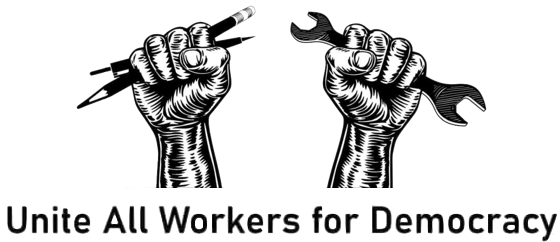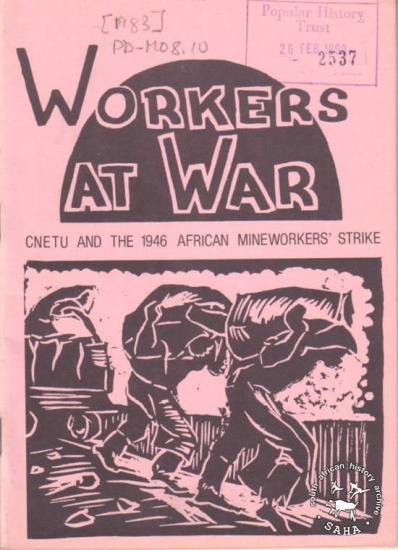Follow Erik Loomis on Twitter
Read Erik Loomis’ work at Lawyers, Guns, & Money
Historian Erik Loomis on This Day in Labor History: August 12, 1946. South African mineworkers went on strike, a critical moment in the struggle against racism and which is one of the major early moments that challenged the apartheid state.
As most of you probably know, mining has always been a big part of the South African economy. Rich in both gold and diamonds, mineral wealth fueled the growth of that colony and then nation.
As all of you know, South Africa became a nation rigidly divided by race, with a white supremacist government maintaining total control over the native African population and ruling it with an iron fist. That included forcing many black men to work in the mines for very low wages.
Mining is a dangerous occupation wherever it exists and when you add racial discrimination into it, the lives of black miners were very bad.
In 1914, the first Secretary of the African National Congress, Sol Plaatjie, wrote, “Two hundred thousand subterranean heroes who, by day and by night, for a mere pittance lay down their lives to the familiar ‘fall of rock’ and who, at deep levels ranging from 1,000 to 3,000 feet in the bowels of the earth, sacrifice their lungs to the rock dust which develops miners’ phthisis and pneumonia.”
English miners had introduced unionism to the South African mines back in the 1880s. Of course, these unions had no room in them for Africans. The first real unions among black miners started in 1941 and even had some limited support from white trade unionists.
The Mine Workers Union represented workers who really were at the bottom of the economic ladder. That year, the average annual wage for a black miner in South Africa was 70 Rands.
For white miners, it was 848 Rands. Five years later, the union had won tiny wage gains, but the ratio was still over 10:1 for white miners. These were wages that didn’t even allow for proper nutrition, not to mention the other basics of life.
Upon the development of the union, the South African government created a commission to study the problem but, of course, just reinforced the desires of the white-owned mining companies.
Tiny wage gains were granted to black workers, but nothing that really mattered, except for the beginnings of overtime pay. Moreover, several MWU leaders were arrested in December 1944 for violating an anti-labor law that banned any meeting of over twenty workers on company property.
Still, the AMU continued to grow. It made another attempt to get the government to grant a 1 Rand a day wage. From May to July 1946, this was its stated goal. The government ignored the union. There were isolated short strikes around the mines through this period.
But nothing got the government to care. It was deeply committed to running the nation on the labor of impoverished Africans. So on August 4, a meeting consisting of over 1,000 miners led to a strike announcement of August 12. The AMU leadership was hardly pie-in-the-sky.
They very much knew that this act would probably lead to violence and miners dying from state repression. They said as much at the August 4 meeting. But workers simply had nothing to lose.
One aging miner shouted back, “We on the mines are dead men already.” The strike planning went forward.
On August 12, the strike began. Workers at 32 of the Rand’s 45 mines participated. There is some evidence that most of the strike leaders were from the eastern Cape or from Lesotho.
It’s pretty clear that people with some tribal affiliations were more willing to strike than some other tribes.
It was an impressive action considering the massive challenges. Unions had so little access to workers and faced so much repression that there wasn’t really very much familiarity with the AMU before the strike began.
It was only in the days before, with a few rank-and-file activists, that any knowledge of the action or even the idea that collective action was possible reached many of the workers.
Some of the workers thought that this was all planned by the white miners union, which was in fact on strike shortly before all of this. The decision to strike was usually made just before the action began, usually just among the workers in a given room who labored together.
Given all of this, there wasn’t much organization or planning. In many ways, this was more like a spontaneous demonstration than a real strike, especially on the eastern Rand, which had less exposure to unions.
The government responded immediately with terror and repression. Thousands of police were sent to the mining areas. There, they forced miners down into the mines using their bayonets
On August 13, a peaceful procession of protesters began a march from the East Rand to Johannesburg. The police opened fire on the march and several workers were killed. In one mine that the police reopened with force, the miners engaged in a sit-down strike.
The police responded by forcing the workers back up to the surface, beating the hell out of them with their batons, and then sending them back down to work.
On August 14, the African-led unions throughout the nation, organized in the Transvaal Council of Non-European Trade Unions (CONETU), called for a general strike in solidarity with the miners. Unfortunately, it did not have the organization to see this through effectively.
The city council urged the workers to not stop essential services but many workers ignored it anyway. The next day CONETU called a mass meeting of workers.
The state banned the action and only the unions calling it off at the last minute stopped a massacre, as the police were clearly going to fire on the crowd. One pregnant worker was bayoneted anyway.
On August 16, the state announced the end of the strike, using total police violence to force the more than 60,000 workers on strike back on the job. Hundreds of workers were arrested and tried for various “crimes.”
Trade union leaders and communists were rounded up and placed on trial for sedition. Many were sent away for long prison terms. A total of nine workers were killed in the strike, with over 1,200 injured.
The strike was a failure. But it was also a critical moment in South African history. Some have argued that this was the moment when the modern resistance to apartheid really began.
Lots of the big movements of the late 1940s and 1950s that began to challenge apartheid systematically were inspired by the miners’ acts.

